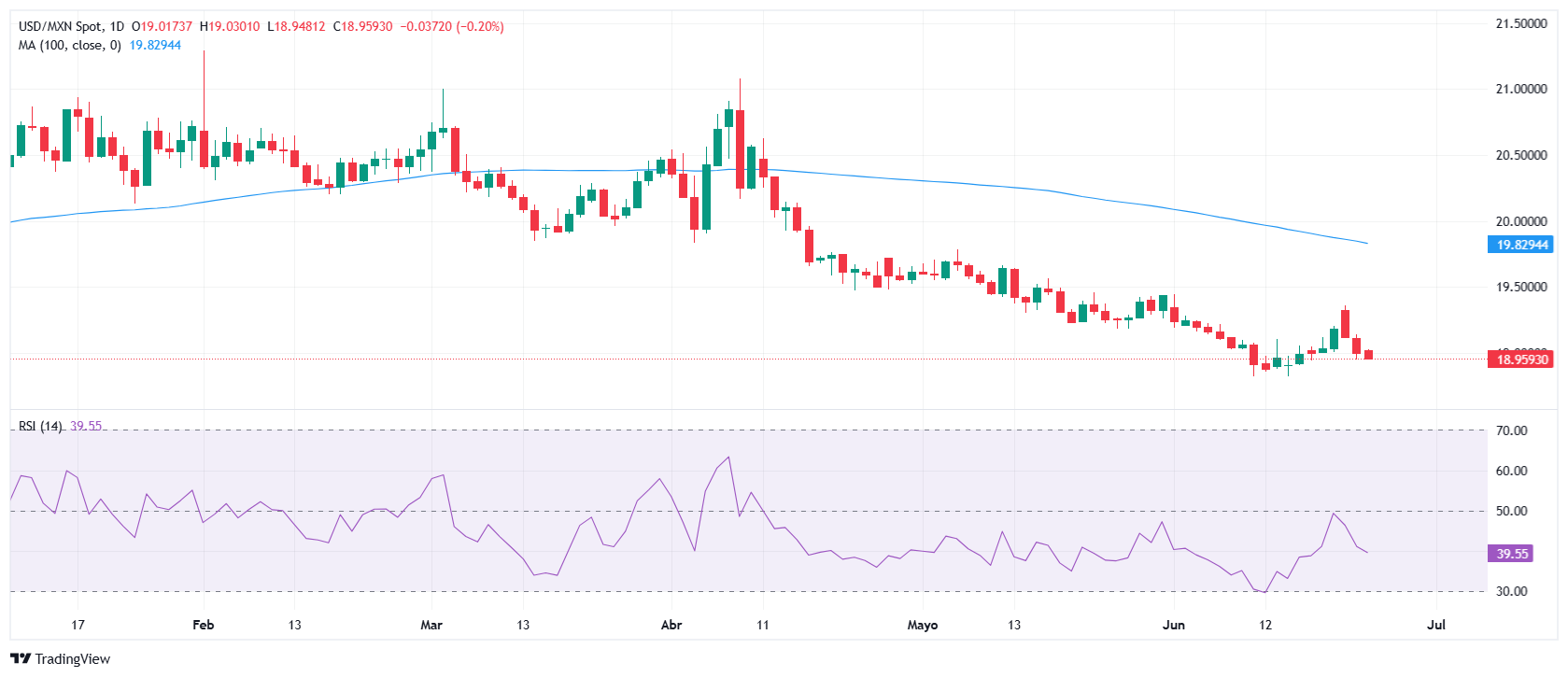- The USD/MXN tries at least one week at 18.94.
- The US dollar awaits Jerome Powell’s second day before Congress after the cessation of the conflict between Israel and Iran.
- After the cessation of the conflict between Israel and Iran, the focus revolves to the Banxico monetary policy decision, which will be announced on Thursday at 19.00 GMT.
- The technical configuration of the USD/MXN continues to point down.
The USD/MXN records losses per third consecutive day on Wednesday, once again trying a week at 18.94 after the opening of Wall Street. At the time of writing, the par quotes over 18.95, losing 0.21% daily.
The US dollar slows its fall covered by the restrictive tone of Jerome Powell
The American dollar index (DXY) has stopped falling on Wednesday, after reaching yesterday its lowest level in nine days at 97.71. After the optimistic reception from the market of the end of the conflict between Israel and Iran, the risk appetite has moderated, braking the fall of the dollar. Information from the Pentagon suggests that the US would not have completely annihilated the Iranian nuclear capacity, noting that it could be remote in a few months. Although Donald Trump has denied this information, arguing that destruction has been total, investors are more cautious at this time.
The green ticket moves today around 98.11, winning 0.14% in the day. This slight rebound is also supported by the words of the governor of the Fed, Jerome Powell, who on his first day of appearance before Congress on Tuesday insisted that the types will not be cut until there are clearer evidence of the impact of tariffs on the economy. Powell will be in the spotlight again today, since he appears for the second day before the US Chamber.
Before her statement, the president of the Boston Fed, Susan Collins, has assured that US monetary policy is well positioned, adding that “it is time of patience and care.”
Will Banxico cut the interest rates in another 50 basic points? The division in the Central Bank reinforces the Mexican weight
The Mexican peso maintains its strength against the dollar despite the slight rebound of the American currency. The Expectation of the decision made by Banxico on Thursday On interest rates support for MXN, since there is division of opinions within the Central Bank.
The market awaits a rate of 50 basic points (PB) at the June meeting, equal to the one held at the three previous meetings. If this prognosis were fulfilled, the types would be at 8%, its lowest level in three years. The decision should not affect the weight, since it is discounted, although a favorable tone to greater flexibility in the Banxico statement could weigh on the currency.
Although it is ruled out that there are no sales, Banxico might surprise with a cut of only 25 bp, maintaining the current MXN strength. He Subgovernor of the Central Bank, Jonathan Heathrecently declared Reuters that “although I am something skeptical that inflation behaves as anticipates the official projection, support a more cautious and prudent approach until inflation converges towards our 3% goal“
USD/MXN Price levels
The Relative Force Index (RSI) is below 40 in short, medium and long term graphics, pointing out a generalized bearish bias in the torque and pointing more falls in the next few hours.
A break this week at 18.94 will find support in 18.82, land of 2025 and the last 10 months reached in June. A break below this level could cause a setback around 18.60, where are the soils of August.
Upwards, the initial resistance is in the area of 19.08/19.05, where the mobile stockings of 100 converge in one and four hours graphics. Above, the region of 19.35/19.45, where are the maximum of June and late May, will contain greater advances.
USD/MXN A DAY GRAPHIC
Mexican weight FAQS
The Mexican weight (MXN) is the most commercialized currency among its Latin American peers. Its value is widely determined by the performance of the Mexican economy, the country’s central bank policy, the amount of foreign investment in the country and even remittance levels sent by Mexicans living abroad, particularly in the United States. Geopolitical trends can also affect MXN: for example, the Nearshoring process (or the decision of some companies to relocate the manufacturing capacity and supply chains closer to their countries of origin) is also considered a catalyst for the Mexican currency, since the country is considered a key manufacturing center in the American continent. Another catalyst for MXN is oil prices, since Mexico is a key exporter of the raw material.
The main objective of the Central Bank of Mexico, also known as Banxico, is to maintain inflation at low and stable levels (in or close to its 3%target, the midpoint of a tolerance band between 2%and 4%). To do this, the bank establishes an adequate level of interest rates. When inflation is too high, Banxico will try to control it by raising interest rates, which makes the indebtedness of homes and companies more cooling, thus cooling the demand and the economy in general. The highest interest rates are generally positive for Mexican weight (MXN), since they lead to higher yields, which makes the country a more attractive place for investors. On the contrary, lower interest rates tend to weaken the MXN.
The publication of macroeconomic data is key to evaluating the state of the economy and can have an impact on the valuation of the Mexican weight (MXN). A strong Mexican economy, based on high economic growth, low unemployment and high confidence is good for MXN. Not only attracts more foreign investment, but it can encourage the Bank of Mexico (Banxico) to increase interest rates, particularly if this fortress is accompanied by high inflation. However, if the economic data is weak, the MXN is likely to depreciate.
As an emerging market currency, the Mexican weight (MXN) tends to rise for periods of risk, or when investors perceive that the general market risks are low and, therefore, are eager to participate in investments that carry a higher risk. On the contrary, the MXN tends to weaken at times of market turbulence or economic uncertainty, since investors tend to sell higher risk assets and flee to the most stable safe shelters.
Source: Fx Street
I am Joshua Winder, a senior-level journalist and editor at World Stock Market. I specialize in covering news related to the stock market and economic trends. With more than 8 years of experience in this field, I have become an expert in financial reporting.








